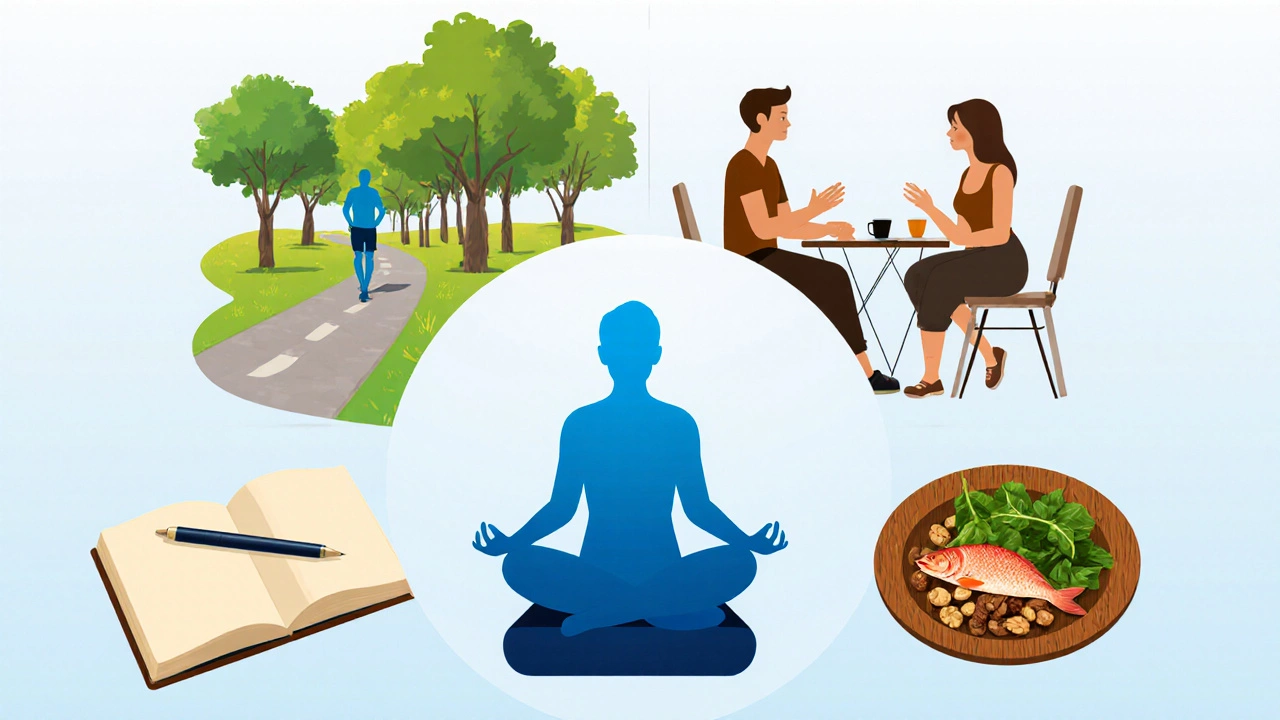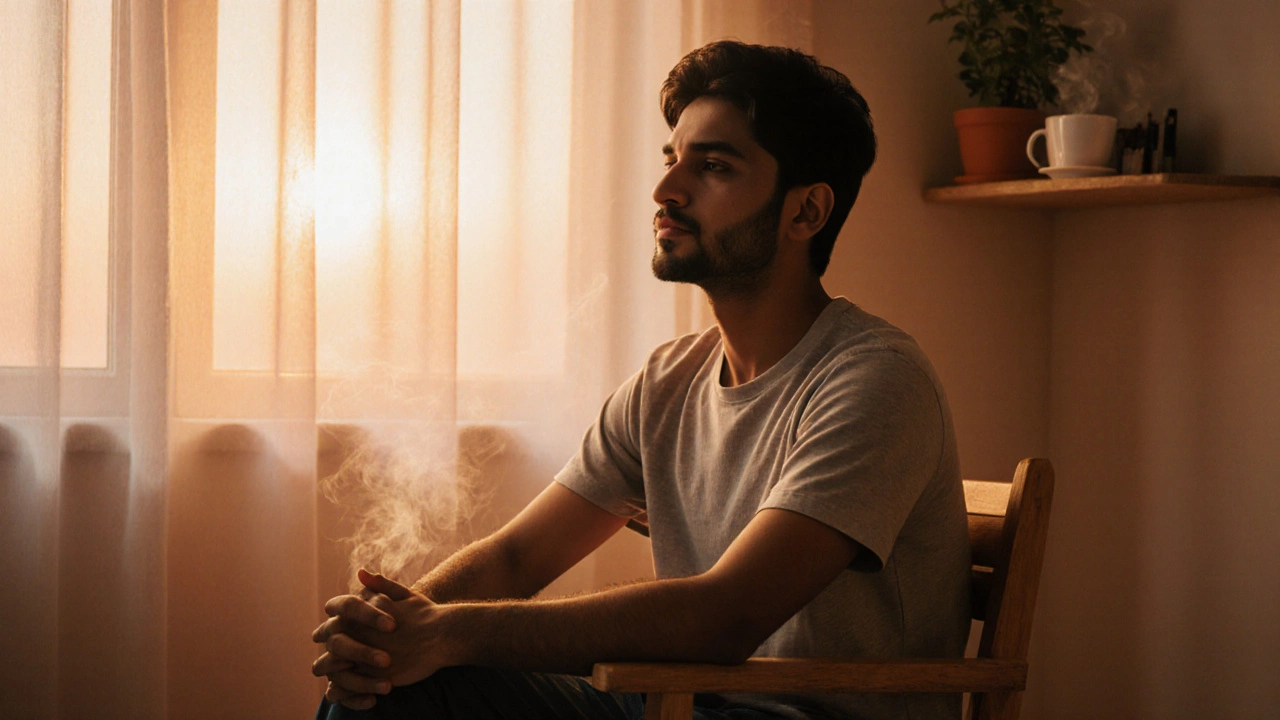Self-Healing Strategy Planner
Step 1: Select Your Techniques
Choose 2-3 techniques from the list below to incorporate into your daily routine.
10-20 min daily • Reduces stress and anxiety
30-45 min, 3-5 times/week • Boosts mood and energy
Weekly meet-ups • Reduces loneliness and stress
5-10 min nightly • Helps process emotions
Ongoing dietary changes • Supports brain health
Step 2: Track Your Progress
Log your mood and activities daily to see what works best for you.
Your Weekly Progress
No entries logged yet. Start logging your daily entries to track your progress!
Pro Tip:
Consistency beats intensity. A 5-minute habit kept for weeks beats a 30-minute sprint you quit after a day. Track your progress weekly to see improvements over time.
Ever wondered if you can recover from anxiety, low mood, or burnout without stepping into a therapist’s office? The short answer is yes-many people find genuine relief using self‑directed tools. But the path isn’t a free‑for‑all; it requires the right mix of science‑backed practices, realistic expectations, and a safety net when things get tough.
Key Takeaways
- Self‑healing works best when you combine several low‑cost habits that target mind, body, and community.
- Evidence shows mindfulness, regular exercise, and social connection rank highest for reducing stress and depressive symptoms.
- Self‑help isn’t a cure‑all; severe mood disorders still need professional oversight.
- A simple personal plan-track mood, pick 2-3 techniques, and review monthly-boosts consistency.
- Know the warning signs that signal it’s time to seek a therapist or psychiatrist.
What is Self‑Healing?
Self‑healing is a set of intentional actions people take on their own to improve mental well‑being without formal psychotherapy. It isn’t magic; it’s a disciplined use of evidence‑based tools that tap the brain’s natural plasticity. Think of it as giving your nervous system the nutrients, exercise, and rest it needs to function better.
Why Some People Prefer DIY Approaches
Cost, stigma, and scheduling hassles push many to explore alternatives. In India, a 2023 health‑economics report found that 42% of adults delayed therapy because of out‑of‑pocket expenses. Self‑help offers immediate access and a sense of agency-two factors linked to better adherence.

Core Self‑Help Pillars
Research consistently clusters effective DIY methods into five pillars. Below each pillar, I introduce a primary technique you can start today.
1. Mindfulness Meditation
Mindfulness meditation is the practice of paying non‑judgmental attention to the present moment, usually through breath awareness. A 2022 meta‑analysis of 47 trials showed a 30% reduction in anxiety scores after eight weeks of daily 10‑minute sessions.
2. Physical Exercise
Physical exercise is any bodily activity that raises heart rate and engages major muscle groups. Even a brisk 30‑minute walk three times a week releases endorphins and improves sleep quality, both crucial for mood regulation.
3. Social Support
Social support is the emotional and practical assistance received from friends, family, or community groups. Studies from the University of Delhi (2021) linked strong support networks to a 25% lower risk of developing depressive episodes.
4. Journaling
Journaling is the habit of writing down thoughts, feelings, and daily events to gain perspective. A simple “three‑sentence” night‑time journal can reduce rumination by up to 40%.
5. Nutrition
Nutrition is the intake of foods and nutrients that support brain function. Omega‑3 rich foods, like flaxseed and fish, have been associated with lower rates of depression in multiple Indian cohort studies.
Self‑Help Strategies Comparison
| Technique | Typical Session Length | Research Support | Best for Issues |
|---|---|---|---|
| Mindfulness meditation | 10‑20min daily | High | Stress, anxiety, mild depression |
| Physical exercise | 30‑45min, 3‑5times/week | High | Low mood, insomnia, ADHD symptoms |
| Social support (peer groups) | Varies - weekly meet‑ups | Medium | Loneliness, grief, chronic stress |
| Journaling | 5‑10min nightly | Medium | Rumination, trauma processing |
| Nutrition tweaks | Ongoing dietary changes | Medium | Mood swings, fatigue |
Putting It All Together: A 4‑Week Starter Plan
- Day1‑7: Begin a 10‑minute breathing meditation each morning. Write a three‑sentence journal before bed.
- Day8‑14: Add a 30‑minute brisk walk after dinner. Replace one snack with a handful of walnuts or a boiled egg.
- Day15‑21: Reach out to a friend you haven’t spoken to in a while; schedule a short coffee or a virtual chat. Attend a local hobby group (e.g., a book club) once.
- Day22‑28: Review your mood log. Notice which activity gave the biggest lift and double‑down on it for the next month.
Track progress using a simple spreadsheet: Date, Activity, Mood rating (1‑10), Notes. Consistency beats intensity; a 5‑minute habit kept for weeks beats a 30‑minute sprint you quit after a day.
When DIY Isn’t Enough
Self‑healing is powerful, but it has limits. Watch for red flags that call for professional help:
- Persistent thoughts of self‑harm or hopelessness.
- Psychotic symptoms-hearing voices, extreme paranoia.
- Functioning deteriorates despite consistent self‑care (e.g., missed work, strained relationships).
- Substance dependence that interferes with daily life.
If any of these appear, reach out to a certified therapist, psychiatrist, or a trusted primary‑care doctor. Combining therapy with self‑help often yields the best outcomes.

Common Pitfalls & How to Avoid Them
- All‑or‑nothing mindset: Skipping a day means you’ve failed. Treat missed sessions as data, not defeat.
- Info‑overload: Jumping from meditation to juice cleanses to yoga retreats can burn you out. Pick two techniques and master them first.
- Isolation: Going solo can feel empowering until loneliness creeps in. Schedule a weekly check‑in with a friend or an online support forum.
- Unrealistic expectations: Healing is a marathon. Expect gradual improvement-often 10‑15% mood lift per month.
Resources You Can Tap Right Now
Below are free or low‑cost tools you can start using without a therapist’s prescription.
- Insight Timer (meditation app) - free guided meditations, many under 10minutes.
- MyFitnessPal - tracks nutrition, can highlight omega‑3 intake.
- Meetup.com - find local peer‑support or hobby groups in Bangalore.
- Daylio - mood‑journal app that generates visual trends.
- National Institute of Mental Health (NIMH) fact sheets - evidence‑based info on self‑care.
Final Thought: Empowered Healing Is Possible
While you heal without therapy may feel like a bold claim, the evidence shows it’s doable for many mild to moderate concerns. The key is a structured plan, realistic expectations, and a safety net for when professional help becomes necessary. Give yourself permission to experiment, track what works, and stay open to seeking a therapist if the journey stalls. Your mind, body, and community can be powerful allies in the recovery process.
Frequently Asked Questions
Can self‑help replace therapy for severe depression?
For moderate to severe depression, self‑help alone is rarely sufficient. Clinical studies show that combining medication or psychotherapy with self‑care yields the highest remission rates. If symptoms interfere with daily functioning, professional assessment is advisable.
How much time should I devote to meditation each day?
Start with 5‑10minutes of focused breathing, gradually increase to 20minutes as it feels comfortable. Consistency matters more than length; a daily habit beats occasional long sessions.
Is talking to friends enough for emotional support?
Friends provide valuable empathy, but structured peer‑support groups often incorporate shared coping tools and accountability, which can amplify benefits. Consider both informal chats and organized meet‑ups.
What if I experience a setback during my self‑help journey?
Setbacks are normal. Review your mood log to spot triggers, adjust the technique (e.g., shorten meditation), and seek a brief consultation if the dip lasts more than two weeks.
Are there cultural practices in India that support self‑healing?
Yes. Practices like yoga, pranayama breathing, and community chanting (kirtan) have documented mental‑health benefits and fit naturally into a self‑care routine.






